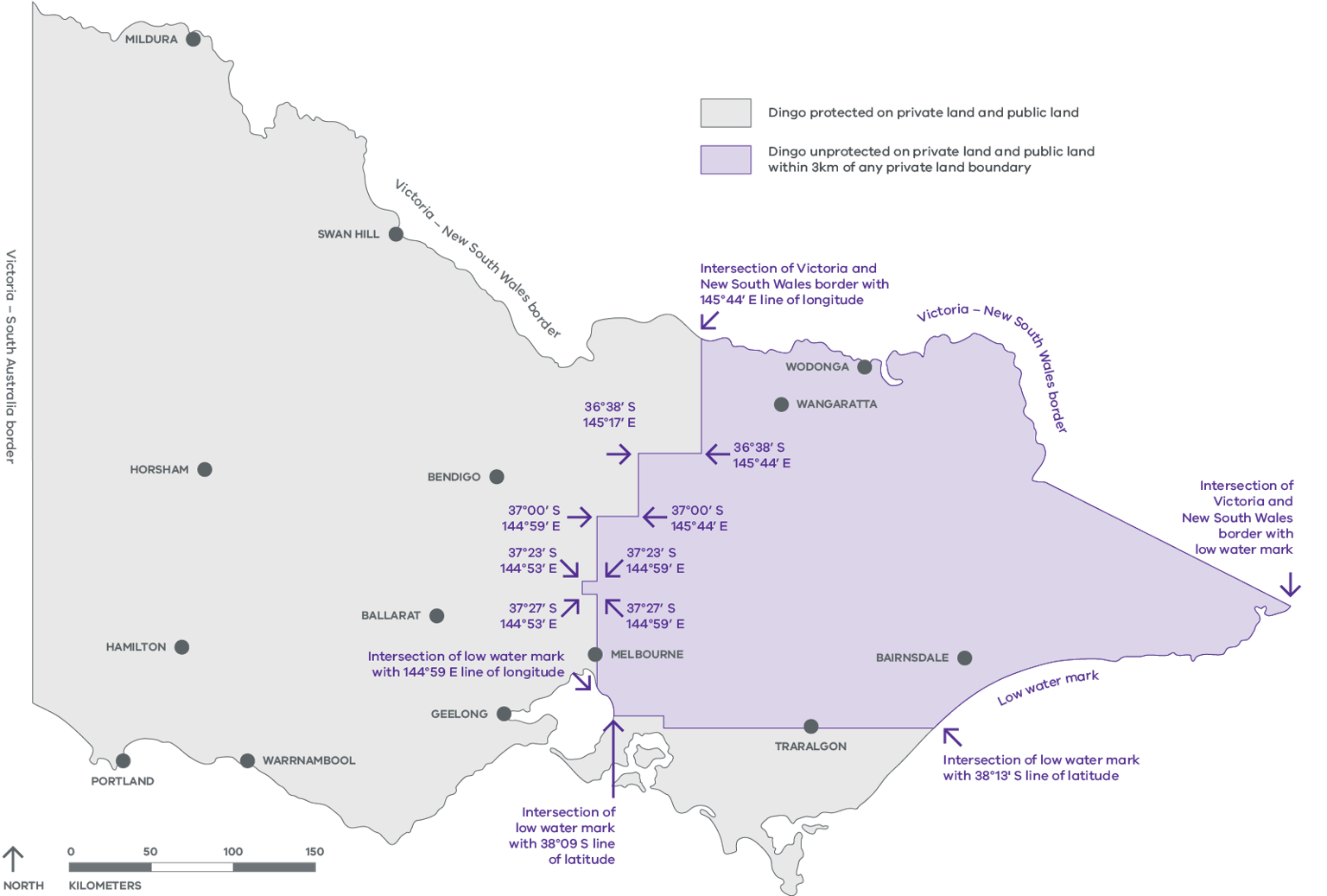- Published by:
- Conservation Regulator
- Date:
- 18 May 2024
Changes have been made to protect dingoes in Victoria’s north-west. Dingoes are protected as a threatened species under the Wildlife Act 1975 and the Flora and Fauna Guarantee Act 1988.
In March 2024, the Victorian Government remade the dingo unprotection order in north-west Victoria due to new scientific information about the local dingo population’s imminent risk of extinction. This was then reinforced with an updated decision in September 2024 to continue this protection until January 2028.
Dingoes are now protected in north-west Victoria, on both public and private land, and it is an offence to destroy them without an authorisation.
Dingoes remain unprotected on both private land and on public land within 3km of the boundaries of any private land within the east of Victoria.
Review of policies
In September 2024, the Department of Energy, Environment and Climate Action completed a review of the policy and regulatory settings for dingo conservation and management in Victoria. The decision was made to extend the unprotection order in the east of Victoria. This remade order will have effect until 1 January 2028.
More information
Visit our dingoes webpage for more about the review.
Read the current Order in Council.
Dingo conservation
Dingoes (Canis lupus dingo) are listed under the Flora and Fauna Guarantee Act 1988 and are currently considered a vulnerable species in Victoria based on their population extent and number, degree of decline, and current and future threats.
Currently, there are two main populations of dingoes in Victoria: a population in the east, and a smaller disconnected population in the north-west (the Mallee) near the Big Desert.
The Mallee population is genetically distinct from other dingo populations across Australia with as few as 40 dingoes left. It is at risk of extinction.
Due to low numbers, the dingo population in Victoria’s northwest is already experiencing inbreeding, and any further loss of dingoes increases the risk of population collapse.
Identifying dingoes in the wild
Dingoes have a range of coat colours, including tan, black, white, and brindle, making it difficult to distinguish dingoes from wild dogs, and there is increasing DNA evidence to indicate most animals previously thought to be wild dogs are dingoes.
Recent DNA testing undertaken in the north-west has not identified any dingo-dog hybrids and land managers are urged to assume that anything previously considered a wild dog is a protected dingo.
Dingo management options
There are a range of wildlife management activities farmers can utilise to protect their livestock, including several non-lethal control measures that can be implemented without a permit. The Conservation Regulator requires applicants to demonstrate that non-lethal control measures to reduce livestock predation have been assessed and, where practical implemented, prior to considering lethal control options.
Suggested methods include:
- Exclusion fencing
- Changed stock management practices
- Guardian animals
Trail cameras are also useful tools for identifying if impacts on stock are from predation or scavenging behaviour, and whether dingoes, escaped domestic dogs, or foxes are responsible.
More information
Visit the integrated wild dog control webpage for more information about these measures.
Disturbing or scaring
It is an offence to wilfully disturb, injure or chase wildlife without an Authority to Control Wildlife (ACTW) under the Wildlife Act 1975. However, the Conservation Regulator considers that land managers who take reasonable reactive measures to non-lethally scare or chase a dingo posing an imminent risk to livestock (such as observed direct attack) will not meet the threshold for regulatory action, as disturbance will have limited short-term welfare impacts on dingoes.
Reasonable reactive measures may include visual or auditory deterrents including spotlights, gas guns, or warning shots by firearm. These measures are not permissible as a long-term approach to disturbance without an ATCW.
Land managers can apply for an Authority to Control Wildlife if they wish to undertake further non-lethal controls.
The Conservation Regulator is legally obligated to consider how the proposed control method will impact the conservation of the species near the site.
Land managers can develop a wildlife management plan to help identify objectives for dingo management and proposed mitigations over the medium- to long term. A plan also allows the land manager to apply for an ATCW in anticipation of damage caused by wildlife and seek authorisation for a combination of control methods.
Lethal control
In light of current scientific evidence that highlights the risk of extinction to the north-west dingo population, the Conservation Regulator will only consider issuing ATCWs for lethal control in extraordinary circumstances, such as where there are human safety concerns, or where there are extreme and escalating livestock impacts and all non-lethal control measures have been exhausted.
The Conservation Regulator will determine if circumstances are extraordinary based on the unique characteristics of an application for lethal control, balanced against the state of the northwest dingo population.
Applications must include evidence of the damage caused by dingo and how all practical available non-lethal control options have been assessed and/or applied.
More information
View applications to control wildlife, including how to apply and what to include in a wildlife management plan for more information.
Further information
- Visit wildlife.vic.gov.au(opens in a new window)
- Visit Authority to Control Wildlife (ATCW) application
- Phone 136 186 8am – 6pm, Monday – Friday
- Email conservationregulator@deeca.vic.gov.au
- Contact your local DEECA regional office(opens in a new window)
